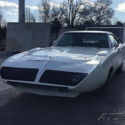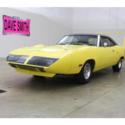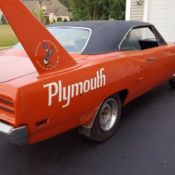1970 Plymouth Road Runner Superbird 28223 Miles Tor-Red 440 cubic inch V8 3-sp
- Condition: Used
- Make: Plymouth
- Model: Road Runner Superbird
- Type: --
- Trim: --
- Year: 1970
- Mileage: 28223
- VIN: RM23U0A169441
- Color: Red
- Engine size: 440 cubic inch V8
- Power options: --
- Fuel: Gasoline
- Transmission: Automatic
- Drive type: --
- Interior color: Black
- Options: --
- Vehicle Title: N/A
- Location: Local pick-up only
Description
Chrysler’s “winged warriors” represent a lot of things: the first cars to go 200 MPH on the high banks of NASCAR, a massive sales flop, and finally, some of the most collectable Mopars of all time. In fact, their single-minded purpose is probably why they are A-list collectables, cars built without regard for marketability or sales figures, but rather simply to go faster than anything else on the track. When new, dealers complained long and loud about not only their... oddness but their sky-high price tag which pretty much rendered them permanent showroom art in the early 1970s. There are stories of these cars having their wings stripped off and retrofitted with standard grilles to make them more palatable to the car-buying public (if you were a guy working a 9-5 job, there’s just no way you’d buy one of these things to commute to work). Some of them sat around for years waiting for a buyer, with reports of new cars still on dealer lots in 1973. Some went racing, although their advantage was so lopsided that most sanctioning bodies outlawed them in short order. And some, like this Tor-Red 1970 Plymouth Superbird, lived charmed lives. The name on the trunk, Spear Chrysler-Plymouth, is the name that’s on the title today and with just 28,223 original miles, this is one of the most amazing survivors we’ve ever seen. In fact, the guys at Spear knew a good thing when they saw it, and after selling their only allotted Superbird in 1970, the father-and-son Spear team couldn’t shake the feeling that they’d made a mistake. A few years later, they bought it back and it has remained with them ever since. There’s little question that the mileage shown is authentic, because this car is extremely well preserved. That’s 100% original code EV2 Tor-Red paint on the bodywork, and while there are a few signs of age, it looks far better than you would expect given the hit-or-miss quality of Chrysler’s work in 1970. Original paint means original sheetmetal underneath and there are obviously no botched repairs, no filler, no rust holes, nothing to cause a new owner any consternation. The flanks are laser straight with not even so much as a parking lot ding in the doors and those loooong quarter panels look as clean as the day they popped out of the press. Panel fit is quite good, particularly the doors and trunk, and the nose cone shows the usual wide gaps that were part of the deal. There’s a soft gloss to the paint that you just couldn’t replicate with modern finishes, but at a show you’ll surely have people arguing that it has been restored—it really looks great. There are a few nicks here and there, but nothing really serious and we’ll leave it to the next owner to decide whether the two pea-sized chips on the left front fender should be touched-up. Most of the decals are original, although the black headlight patches on the nose have been replaced recently because the originals had been removed at some point. But the billboards, the Road Runner Superbird cartoon logos on the wing uprights, and even the little Road Runner on the tail were all installed at Hamtramck in 1970. All Superbirds received a vinyl top as part of the package—converting the flying buttress rear window to a more aerodynamically-friendly semi-fastback required a fiberglass plug and window, and rather than trying to make all that look right, the factory just pasted on a vinyl top and called it done. That’s also why you get those weird little body fillers at the base of the C-pillars, too. This is undoubtedly the original vinyl top and it’s in fantastic condition with no tears, bubbles, or other signs of distress. The black bench seat interior is likewise 100% original, including seatcovers, carpets, headliner, and door panels. Superbirds cost more than a $1000 more than a Road Runner, so most were stripped-down models in an attempt to get them out of the showrooms, and this is no exception. Then again, if you appreciate purity of purpose, then the built-for-combat attitude this car exhibits might be appealing. The seats remain firm and comfortable, the dash pad is unmarked, and even the seat belt webbing remains supple and clean. Everything works, including the gauges and original Music Master AM radio, and even the traditional “Beep! Beep!” Road Runner horn sounds right. Some aftermarket floor mats have been added to cover some threadbare areas on the passenger’s side, but that appears to be the lone addition to a passenger compartment that is otherwise exactly as it was in 1970. Just look at that headliner if you have any doubts about the quality of this car! The trunk is also correctly detailed with its original mat, original F70-14 bias-ply spare tire (a narrow white wall, interestingly enough) and BOTH jacks, which were required for the ‘Bird’s extended beak. Even the original jacking instructions are still clinging to the underside of the trunk lid. Nice! That is, of course, the original, numbers-matching 440 cubic inch Super Commando V8, and it has never been out of the car. You can see by just how clean the engine bay is that this Superbird has lived an easy life, and while it has been serviced properly over the years, it has never been restored. Recent service includes a full tune-up, fresh hoses, belts, and battery cables, and a rebuilt master cylinder (rebuilt, not replaced!). However, that’s original Hemi Orange engine enamel, factory decals on the various components, and the factory-installed overflow tank perched on the passenger-side inner fender (you know it’s OEM because the cap opens towards the front while the repros open towards the rear). It starts easily, idles properly, and pulls the car around with genuine authority—that’s why big blocks are so special. It should be bulletproof reliable for decades to come and while survivors are special, this one is also tough so you don’t have to be afraid of driving it. I think you’ll be pleasantly surprised by how well this car works; that’s the joy of original cars. No matter how good your restoration shop might be, they’re still not as good as the factory. The 375 horsepower 440 is backed by the original, numbers-matching TorqueFlite 3-speed automatic transmission. It seems to ignore all that torque and cranks off smooth upshifts and crisp downshifts when you tickle the throttle. Like the engine, it has been recently serviced and works properly with zero issues save for a little seepage from the rear seal—totally normal and not even serious enough to consider replacing the seal. The factory 8.75-inch rear end still hangs on its original leaf springs and carries 3.54 gears, making this a car that really is user-friendly in the real world. After all, that big block doesn’t need a lot of gear to get this car rolling and it was obviously built for high-speed cruising. The recent service work also included a brand new reproduction dual exhaust system that looks, fits, and sounds right, new shocks, and a new gas tank out back. The brakes were rebuilt and feature new hoses and a new left-front brake caliper. It’s a little dirty underneath but it has never seen winter weather so rust should be a non-issue and aside from surface scale on the heavy iron parts, it’s quite clean. You could probably take it up a notch by wiping it down, but then again, go drive it instead. New 235/70/15 BFGoodrich T/A radials were recently installed. The car comes with its original Chrysler Corporation Broadcast Sheet and owner’s manual. The hobby has embraced survivors, and while restored cars can be comforting in their fresh shininess, there’s still nothing that drives better than a car that has never been disassembled. If you’re a Mopar fan with experience, you’ll feel it the moment you slam the door on this Superbird and the way it goes down the road will be especially delightful. Add in the bulletproof pedigree, awesome ownership history, and remarkable preservation and you get a car that stands out in an increasingly crowded field. The wing cars are
 1970 383 cubic inch 4-speed PLYMOUTH ROAD RUNNER
1970 383 cubic inch 4-speed PLYMOUTH ROAD RUNNER
Mileage: 88,683
 1970 Plymouth Superbird 500 Miles Alpine White Hardtop 440 cubic inch V8 Automa
1970 Plymouth Superbird 500 Miles Alpine White Hardtop 440 cubic inch V8 Automa
Mileage: 500
 1970 Plymouth Road Runner Superbird, Yellow with 85,150 Miles available now!
1970 Plymouth Road Runner Superbird, Yellow with 85,150 Miles available now!
Mileage: 85,150
 1970 Plymouth Road Runner SuperBird RARE Classic Under 41k Original Miles FSBO
1970 Plymouth Road Runner SuperBird RARE Classic Under 41k Original Miles FSBO
Mileage: 40321
 1970 Plymouth Road Runner Superbird
1970 Plymouth Road Runner Superbird
Mileage: 52,053
 1970 Plymouth Road Runner Superbird for sale!
1970 Plymouth Road Runner Superbird for sale!
Mileage: 85150
 1970 Plymouth Road Runner Superbird BARNFIND
1970 Plymouth Road Runner Superbird BARNFIND
Mileage: 43,605
 1970 Plymouth Road Runner Superbird Tribute mopar
1970 Plymouth Road Runner Superbird Tribute mopar
Mileage: 35
 1970 Plymouth Road Runner Superbird BARNFIND Survivor
1970 Plymouth Road Runner Superbird BARNFIND Survivor
Mileage: 43,615
 1970 Plymouth Road Runner SUPERBIRD, Numbers Match, 440-4 BBL Auto, 1 of 3
1970 Plymouth Road Runner SUPERBIRD, Numbers Match, 440-4 BBL Auto, 1 of 3
Mileage: 59,500











